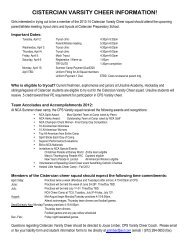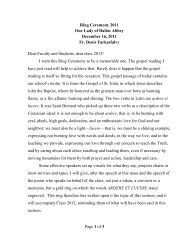September 2000: "The Hillary Legacy" - Cistercian Preparatory School
September 2000: "The Hillary Legacy" - Cistercian Preparatory School
September 2000: "The Hillary Legacy" - Cistercian Preparatory School
Create successful ePaper yourself
Turn your PDF publications into a flip-book with our unique Google optimized e-Paper software.
K. Pomorski and K. Dietrich: Derivation of a Proximity Interaction 357corresponding energy density ~are given by:tance Rle=LR1-R21 (see Fig. 2):E =~d3xJfEp,, pp, %, Zp, J,,Jp] (2.1)h 2+ l(t 1 + t2) pz + ~(t 2-tl)(p~ z, + ppzp)+ ~66(t2 - 3 tl)p A p +3~2(3 t 1 + t2)(p,A p, + ppA p,)+ 88 0, p + - +-89 w.(pv.J + p,v.J, +(2.2t<strong>The</strong> densities (p~, pp, p), the kinetic densities (%, Zp, z)and the spin densities (J,,Jp,J) are defined in termsof the single particle functions ~bl "), ~bl p) of neutronsand protons by:Atp,(x) = ~ I~bl'~ 2 (2.3)i=1Zp (x) = 2 (2.3')i=1p (x) = p, (x) + p p (x) (2.3")N~,(x) = ~, IV ~Ol")(x)l 2 (2.4)i=1Zzp(x)= Z ]V(blP)(x)I 2i=1(2.4')z (x) = z, (x) + zp (x) (2.4")J,(x)=-i~Ni=1Z~(")*trl , ,a)(Vq~l')(r,a')x(alala')) (2.5)-Jp(x) = --i ~ qOlP)* (r , a)(VcrplV)(r, a')(al a I(r'))i=1(2.5')J (x) = ~r (x) + Jp (x). (2.5")<strong>The</strong> set of parameters to, tl, t~_, t3, x and W (referredto as "Skyrme parameters") defines the effective interaction.Different Skyrme forces are distinguishedby different sets of parameters (see Table 1 andRef. 5). As already discussed in w 1, the densities (2.3-2.5) depend parametrically on the constraints whichimply that there are two spherical nuclei with givennumbers of neutrons and protons at a given distanceR~2. Whenever this distance is larger than the sum ofthe liquid drop radiiR12~RLD+R LD (2.6)we expect that the "polarization" of the unperturbeddensity distributions is small. Consequently, we makethe "Ansatz" that the total density p is a sum of twospherical Fermi distributions (radii/~,/~2) at a dis-p(x)= pa (IX- R11) + pz(IX- R21) (2.7)p o-(IX- R,~I)a=(1, 2)and that the neutron densities p.,~ and proton densitiespp,~ for the two interacting nuclei differ fromp~ by scaling factors only:p,,~.=~p~ (2.91Z~pp,~: =~p~.1 (2.11)p,,o =~(1 +I~)p~pp,~=89 -I~)p~(2.11'),On =,On1 + Pn2 (2.12)Pp =Ppl +Pp2"(2.12')Using the Thomas-Fermi approximation [6J, we expressthe kinetic density z,(zp) of neutrons (protons)by the neutron (proton) density p,(pp):7-c4/3 35/3 05/3 =cgps/3(x )z.(x)= 3 (2.13)cd = 5.7424(2.13')zp (x) = cg pSv/3 (x). (2.14)Decomposing the total neutron (proton) densityp,(pp) into the parts originating from the two nucleiaccording to (2.12) ((2.12')) we find75nZ"fnl "~- 75n25/3 1 -5/3%o=Cgp,~ =oK. [~(1 +io)]5/3 PaTp =Tpl-~Tp2z,o = cg p~? = (d [89 -I~)] 5/3 p~/3.(2.9')<strong>The</strong> vectors R~ point from the origin of the coordinatesystem to the centre of the distribution p,. <strong>The</strong>parameters N~, Z~, A~ represent the number of neutrons,protons and nucleons in nucleus a(= 1, 2) respectively.Choosing the nucleon numbers A~ and the thirdcomponents T3 (') of the isospinT(3~ )-N~-Z~2 =~-.A~I~ (2.10)as independent variables, we have(2.15)(2.15')(2.16)(2.16')
















